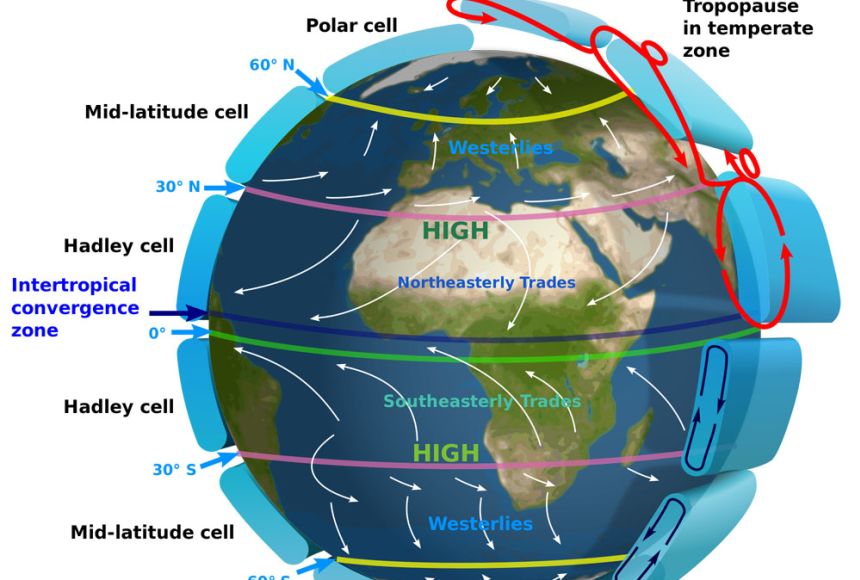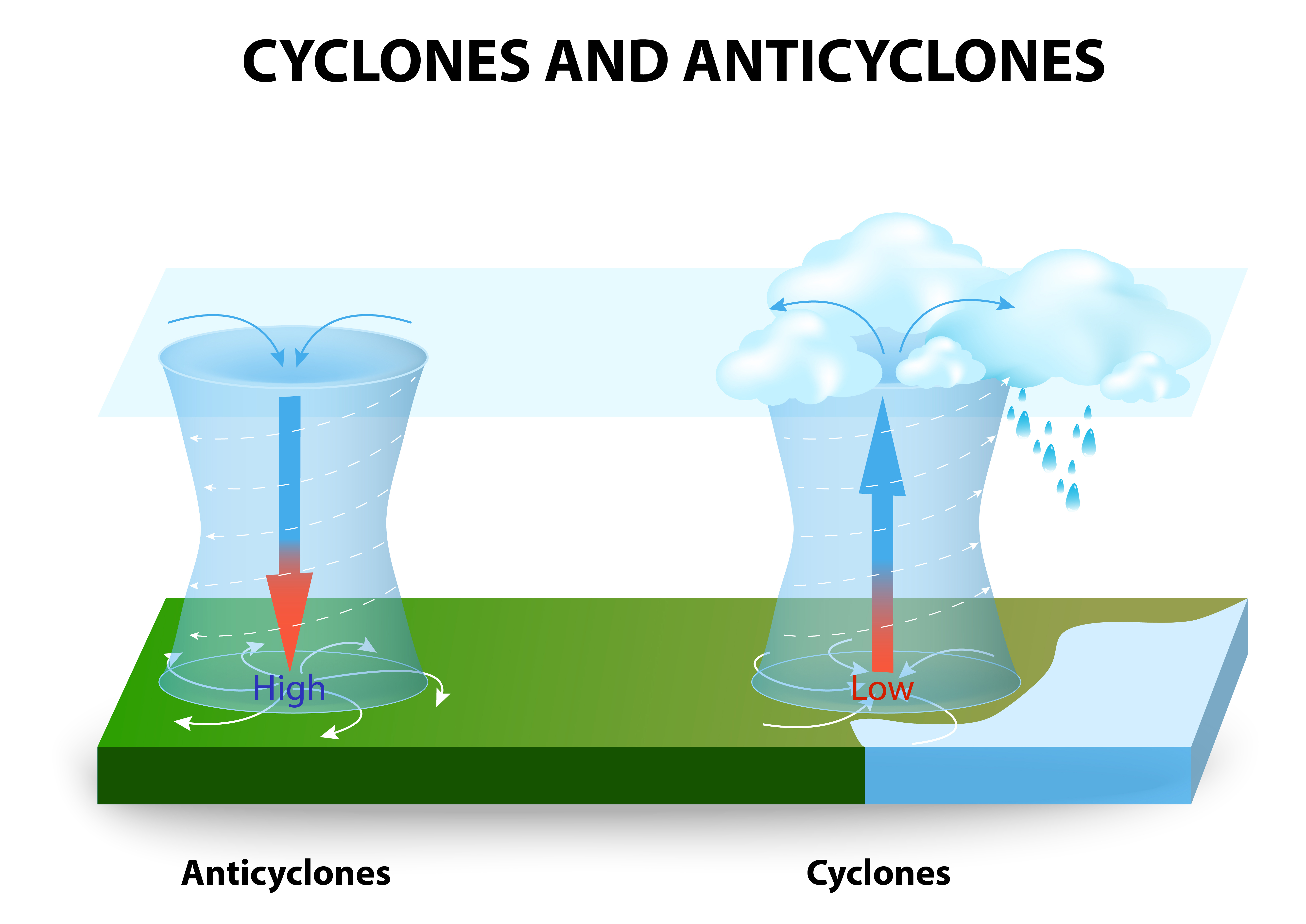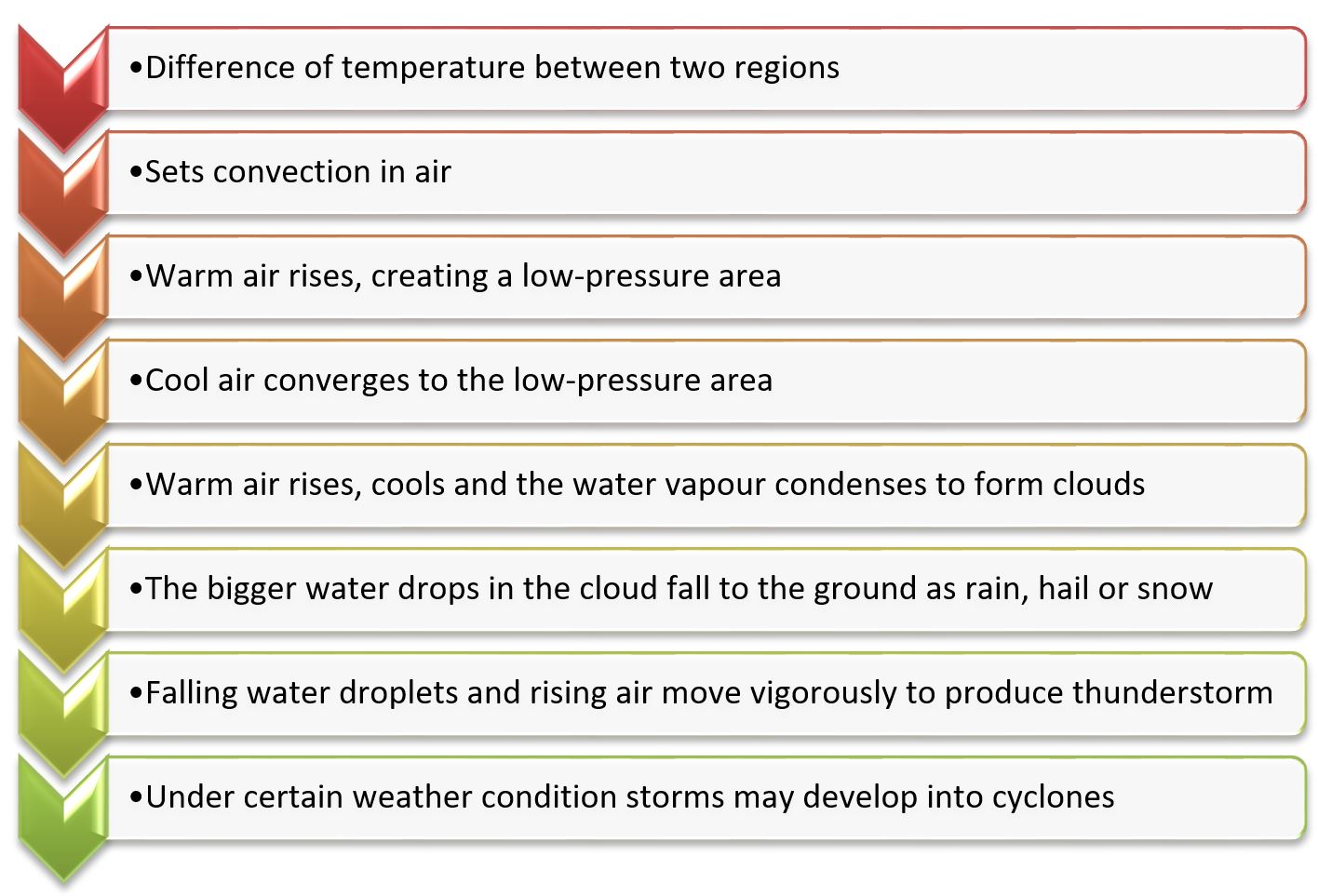Winds, Storms and Cyclones Class 7 Notes NCERT and MCQs
 06-09-2023
06-09-2023
 11:59 AM IST
11:59 AM IST
 Yadvendra Singh
Yadvendra Singh
The chapter discusses air, wind and wind movement due to uneven heating of Earth. It also explains the processes leading to the formation of thunderstorms and cyclones.
Air
Moving air is called the wind. Air around us exerts pressure. High speed winds are accompanied by reduced air pressure.
Air moves from the region where the air pressure is high to the region where the pressure is low.
The greater the difference in pressure, the faster the air moves. Air expands on heating and contracts on cooling.
Wind
The warm air is lighter than the cold air. That is the reason that the smoke goes up. Warm air rises up, whereas comparatively cooler air tends to sink towards the earth’s surface. As warm air rises, air pressure at that place is reduced and the cooler air moves to that place. The moving air is called wind.
Uneven heating on the earth is the main cause of wind movements.
An anemometer is used for measuring the speed of wind.
Wind due to uneven heating of Earth
At the equator: The air in the regions close to the equator gets warm as these regions get maximum heat from the Sun.
The warm air rises, and the cooler air from the regions in the 0–30 degrees latitude belt on either side of the equator moves in. As a result, the winds blow from the north and the south towards the equator.
At the poles: At the poles, the air is colder than that at latitudes about 60 degrees.
The warm air at these latitudes rises up and the cold wind from the polar regions moves in, to take its place. In this way, wind circulation is set up from the poles to the warmer latitudes.

Figure showing wind flow pattern because of uneven heating on the earth (Source: National geographic)
Winds due to uneven heating of land and water
In summer, near the equator the land warms up faster and most of the time the temperature of the land is higher than that of water in the oceans. The air over the land gets heated and rises. This causes the winds to flow from the oceans towards the land. These are monsoon winds. In winter, the direction of the wind flow gets reversed. It flows from the land to the ocean.
Thunderstorms
Thunderstorms develop in hot, humid tropical areas like India very frequently. The rising temperatures produce strong upward rising winds. These winds carry water droplets upwards, where they freeze, and fall down again.
The swift movement of the falling water droplets along with the rising air creates lightning and sound. This is called as thunderstorm.
Cyclones
A cyclone is called a ‘hurricane’ in the American continent. In Philippines and Japan it is called a ‘typhoon’. The whole coastline of India is vulnerable to cyclones, particularly the east coast. The west coast of India is less vulnerable to cyclonic storms both in terms of intensity and frequency of the cyclones.
Structure of cyclone
The centre of a cyclone is a calm area, called the eye of the storm. The eye of the storm is a region free of clouds and has light winds. Around this calm and clear eye, there is a cloud region. In the cloud region, there are high-speed winds (150–250 km/h) and thick clouds with heavy rain. Away from this region the wind speed gradually decreases.
Formation of cyclone
Before cloud formation, water takes up heat from the atmosphere to change into vapour. When water vapour changes back to liquid form as raindrops, this heat is released to the atmosphere. The heat released to the atmosphere warms the air around. The air tends to rise and causes a drop in pressure. More air rushes to the centre of the storm. This cycle is repeated. The chain of events ends with the formation of a very low-pressure system with very high-speed winds revolving around it. This weather condition is called as cyclone.

Diagram showing cyclone and anticyclone
Destruction caused by Cyclones
Water moving towards the shore enters the low lying coastal areas, causing severe loss of life and property.
It also reduces the fertility of soil.
High-speed winds accompanying a cyclone can damage houses, telephones and other communication systems, trees, etc., causing tremendous loss of life and property.
Tornadoes
Tornadoes are not very frequent in India. A tornado is a dark funnel shaped cloud that reaches from the sky to the ground. Most of the tornadoes are weak. A violent tornado can travel at speeds of about 300 km/h. Tornadoes may form within cyclones.
The phenomena that lead to the formation of clouds and falling of rain and creation of storms and cyclones are summarized in the following flowchart.
Effective Safety Measures
- A cyclone forecast and warning service.
- Rapid communication of warnings to the Government agencies, the ports, fishermen, ships and to the general public.
- Construction of cyclone shelters in the cyclone prone areas, and Administrative arrangements for moving people fast to safer places.
- Action on the part of the people
- We should not ignore the warnings issued by the meteorological department through TV, radio, or newspapers.
- We should — make necessary arrangements to shift the essential household goods, domestic animals and vehicles, etc. to safer places;
- Avoid driving on roads through standing water, as floods may have damaged the roads;
- Keep ready the phone numbers of all emergency services like police, fire brigade, and medical centres.
MCQs based on NCERT Class 7 Science Chapter 8: Winds, Storms and Cyclones
1. Thunderstorms develop very frequently in which of the following ?
a. Hot, dry tropical areas
b. Hot, humid tropical areas
c. Wet, humid tropical areas
d. Wet, hot tropical areas
Ans. b
Explanation: Thunderstorms develop in hot, humid tropical areas like India very frequently. The rising temperatures produce strong upward rising winds. These winds carry water droplets upwards, where they freeze, and fall down again. The swift movement of the falling water droplets along with the rising air creates lightning and sound. This is called as thunderstorm.
2. Which of the following is correct with regard to vulnerability of Indian coasts to cyclones?
a. East coast of India is less vulnerable
b. West coast of India is less vulnerable
c. Both coasts are equally vulnerable
d. Nothing can be said about vulnerability
Ans. b
Explanation: The whole coastline of India is vulnerable to cyclones, particularly the east coast. The west coast of India is less vulnerable to cyclonic storms both in terms of intensity and frequency of the cyclones.
3. A cyclone is called a ‘hurricane’ in which of the following?
a. American continent
b. Philippines
c. Japan
d. Both a and b
Ans. a
Explanation: A cyclone is called a ‘hurricane’ in the American continent. In Philippines and Japan it is called a ‘typhoon’.
4. Which of the following correctly describes a cyclone?
a. A very low-pressure system
b. A very high-pressure system
c. A very low-pressure system with very high-speed winds
d. A very high-pressure system with very low-speed winds
Ans. c
Explanation: A cyclone is a very low-pressure system with very high-speed winds revolving around it. The centre of a cyclone is a calm area, called the eye of the storm. The eye of the storm is a region free of clouds and has light winds.
5. Which one of the following place is unlikely to be affected by a cyclone?
a. Chennai
b. Mangaluru (Mangalore)
c. Amritsar
d. Puri
Ans. c
Explanation: Amritsar is least likely to be affected by a cyclone because this city does not lie near to any coastal area.
6. Which of the statements given below is correct?
a. In winter the winds flow from the land to the ocean.
b. In summer the winds flow from the land towards the ocean.
c. A cyclone is formed by a very high-pressure system with very high-speed winds revolving around it.
d. The coastline of India is not vulnerable to cyclones.
Ans. a
Explanation: In winter the winds flow from the land to the ocean. A cyclone is formed by a very low- pressure system with very high-speed winds revolving around it. The coastline of India is vulnerable to cyclones.
Frequently Asked Questions (FAQs) about Winds, Storms and Cyclones
Why holes are made in hanging banners and hoardings?
What is a Cyclone?
What is wind?
What is the direction of the movement of air?
Share Blog

 Latest
Latest 
Comments